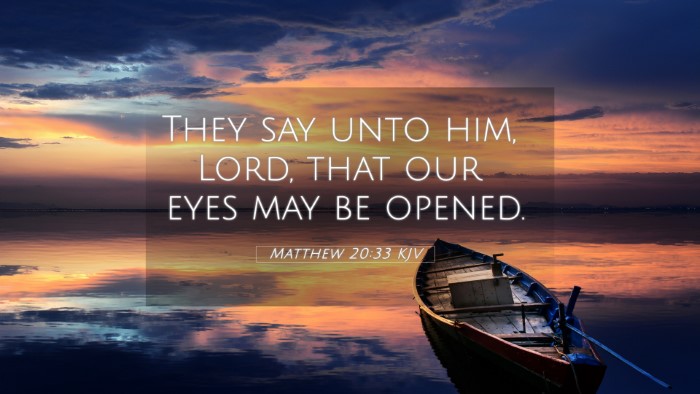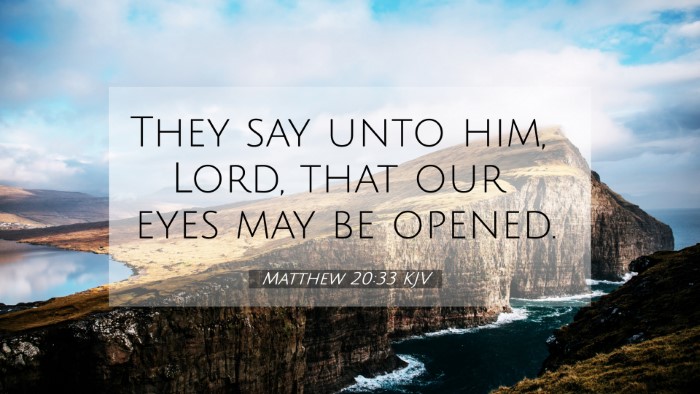Understanding Matthew 20:33
Matthew 20:33 recounts a poignant moment where two blind men call out to Jesus for mercy, specifically saying,
"Lord, that our eyes may be opened." This verse encapsulates deep themes of faith, desperation, and
the transformative power of Jesus. Commentaries from respected sources like Matthew Henry, Albert Barnes,
and Adam Clarke provide valuable insights into this powerful plea.
Context of the Verse
This passage occurs as Jesus is leaving Jericho, highlighting His compassionate response to those in need,
even as a crowd presses around Him. Understanding this context is crucial for interpreting the significance of
the blind men’s request and the lessons that follow.
Commentary Insights
-
Matthew Henry:
Henry emphasizes the personal nature of the blind men’s plea. It reflects a universal human condition:
the blindness of sin and the need for divine illumination. Their cry demonstrates faith in Jesus’
power to heal, which serves as a model for believers to seek the Lord earnestly.
-
Albert Barnes:
Barnes draws attention to the persistent faith of the blind men. Despite being rebuked by the crowd,
they do not falter in their appeal. This persistence in faith shows a profound understanding of Jesus’
authority and compassion, serving as an encouragement for Christians to boldly approach God with their
needs.
-
Adam Clarke:
Clarke points out the social and spiritual implications of blindness in Biblical times. He notes that
blindness not only represents physical impairment but also the spiritual blindness present in many.
The plea of the blind men also signifies a deeper yearning for spiritual enlightenment and restoration.
Thematic Connections
Matthew 20:33 connects profoundly with other biblical texts, providing a rich framework for comparative analysis.
Here are some notable cross-references:
-
Mark 10:51: A parallel account where Jesus asks Bartimaeus, "What do you want me to do for you?"
This highlights the personal engagement of Christ.
-
John 9:35-38: The healing of a blind man, emphasizing that spiritual blindness is a key
theme of Jesus’ ministry.
-
Isaiah 35:5-6: Prophetic verses about the coming of the Messiah, which include the opening of blind eyes.
-
Luke 4:18: Jesus declares His mission to bring sight to the blind, fulfilling Isaiah’s prophecy.
-
Matthew 11:5: Jesus refers to miracles of healing, reinforcing His authority and the hope
He brings to the afflicted.
-
Romans 10:14: Explores the importance of proclaiming the Gospel, likened to opening the eyes of the blind.
-
2 Corinthians 4:4: Discusses spiritual blindness and the light of the Gospel, resonating with the
opening of the blind men’s eyes.
Applying the Verse
This passage invites reflection on our personal areas of blindness—whether physical, spiritual, or emotional.
It emphasizes the importance of bringing our needs to Christ in faith. As believers, we are encouraged to
identify our struggles and present them to Jesus, who is ever willing to listen and respond with mercy and healing.
Conclusion
The significance of Matthew 20:33 extends beyond the miracle of healing; it encapsulates a broader spiritual
message about faith, persistence, and the transformative nature of Christ's compassion. By exploring this verse
through various commentaries and inter-Biblical connections, we unveil deeper understanding and applicable
truths that resonate within the Christian experience.
SEO Content on Cross-Referencing
Understanding biblical texts often requires tools for Bible cross-referencing, aiding in the exploration of
connections between Bible verses. By engaging in a comparative Bible verse analysis, believers can uncover
thematic Bible verse connections that enrich their spiritual journey. Resources such as a Bible concordance and
cross-reference Bible study guides can enhance one's ability to find and identify connections between Old and
New Testament passages.
For those interested in discovering links between specific themes, detailed studies—such as those focusing on
the life of Jesus, the teachings of the Apostles, or the prophetic words of the Old Testament—are vital. Engaging
in cross-referencing Bible study methods allows for a richer, more comprehensive understanding of Scriptures,
deepening one's faith and knowledge of the Bible.




